The Cow Parade
Robert Sievert
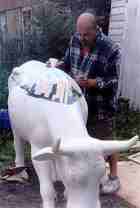 Robert Sievert working on "Harbor Park Cow"
Robert Sievert working on "Harbor Park Cow"
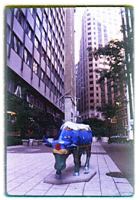 "Harbor Park Cow" on site (1)
"Harbor Park Cow" on site (1)
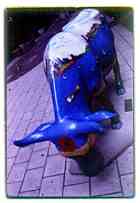 "Harbor Park Cow" on site (2)
"Harbor Park Cow" on site (2)
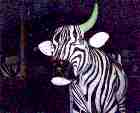 Susan Rocker's "Greenhorn" in her kitchen
Susan Rocker's "Greenhorn" in her kitchen
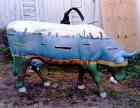 Finished "Harbor Park Cow"
Finished "Harbor Park Cow"
 "Harbor Park Cow" with adoring fan
"Harbor Park Cow" with adoring fan
The first catch however was that the artists had to sign away any rights to their designs. New York Cowparade would own the artist's designs. A most unusual situation, never heard of my anyone previously.
I called at least four friends to tell them the news. You could download the entry form from a web site. They were paying money and it sounded like fun. Enthusiasm waxed high in the art world where everyone suffers from under exposure.
When the first N. Y. Times article appeared and I was not yet selected, I became so agitated that I threw the paper across the room and then got up to stomp on it.
They said they would let you know by the end of April and just possibly in the early May . I finally got a call about May 20th and the cow was to be ready May 26th.
I visited Susan's cow painting site, her kitchen, several times during the painting. In her kitchen the cow seemed enormous. It seemed to fill the entire space. One had to squeeze and gyrate to get a view of the various parts, and a total view was really not possible.
Needless to say like most of Susan's work, her cow was the epitome of neatness and precision. She painted black zebra stripes onto the cow with a daunting exactness. One horn was painted green which gave it its name. I asked her how she had gotten such a terrific stripe pattern and she told me she had found a site on the web with many different kinds off zebras.
Her cow was finished like a Buick, no spots or drips, each line and shape exactly what it was meant to be.
Back to my experience, I originally designed a cow based on a series of paintings done last fall, a series of harbor paintings. I called it Harbor Cow. Dividing the cow's anatomy into three zones, horizontal bands as it were, the top band was a skyline that wrapped completely around the cow. The middle zone was the harbor, with all the kinds of boats and objects, and the bottom which included her legs and udder was painted green with figures of people. The landscape part was clearly a park and I painted bridges around the udders. Under The bridges I added aquatic life.
The Cow Parade suggested using a "cow kit", a set of special acrylics by Lascaux available at New York Central for $230.00. The original cost of these paints would come to over $400.00 if bought separately. I went ahead and bought them. They were perhaps the finest acrylics I have ever used, smooth, intense, and nicely packaged.
It took about two weeks to paint my cow, I had to keep up with a teaching schedule but it went well. I painted her in the outdoor area by my studio. The project was truly exhilarating. She became big neighborhood hit. People wanted to be photographed next to her and everyone loved it.
My landscape design was carefully painted into the curving forms of the cow. At first I worried about this undulating surface but once I began to paint it I found that the curves and bumps could add dimension to my space. I painted a bridge into a recess which gave a certain spatial twist that I found quite entertaining. Rather than being a challenge, my cow form became an opportunity for new adventures in placement.
Early in June a truck came and took her away to the city.
From this point on the cow parade became an event that I watched with both rapt interest and also disappointment. The party turned out to be an event in a nightclub that other groups were attending. Cow Parade Artists were offered free admission and a free drink at the bar. No one I know attended.
First report of the doings came from a friend who works in licensing. He attended a licensing convention at The Javits Center where the cows were being marketed aggressively. Because the artists had signed away their rights, this was an area of potential profit for the Cowparade. This was a hot topic at the convention. Most of the licensing agents found this to be a direct infringement on the artist's domain. My friend told me that they felt the artists could reclaim their rights to their designs through a class action suit.
Next the web site was up and running but only contained a few of the cows. This was the only way one could find out the location of their cow. Cow Parade didn't waste a nickle letting us know anything, especially where our cows were. When one typed in the name of the cow or the artist a coming soon sign appeared with the cow's name, a location, and the artist's name.
I finally discovered my cow's location when a friend telephoned to say that another friend of ours had seen it downtown below Wall Street. It turned out to be on Hanover Square, a small triangular park surrounded by modern and historic buildings. I was shocked by the condition of my cow when I saw her. There were several scrapes on the most outward dimensions of her sides, these must have been done in the moving process, as well as a number of black scuffs. I quickly brought my paints to the site to make repairs. I later realized that these scuffs were made by the shoes of children whose parents lifted them onto the cow's back.
Also they had renamed her Harbor Park, I could not quarrel with this as it incorporated the bottom layer of the design which clearly was a park.
Cow-viewing became a sport amongst my friends.
The first cows I saw were on the boardwalk at South Beach, Staten Island where I ride my bike several times a week. There were three cows, the best one by a group of 6th Grade students who painted Starry Night by Vincent Van Gogh onto a cow. It was extremely well done. Shortly after they appeared, they disappeared. What? I later learned that they had been attacked and dragged off. When found they were placed in the "Cow Hospital", a site where a group of artists worked to restore damaged cows which were later assigned different sites.
I soon began to see cows all around the city. There was one done by some relative of Winston Churchill on Houston St. She had given up politics for an art career (according to the New York Times). Her cow had hands painted all over it and an astonishing unaccomplished technique.
One of the most annoying things about the whole event was the cutesy tags they put on everything, interposing the words cow and moo into everything "Moo York" "Picowcasso"(read cow/picasso) I guess I'm just a bit too serious.
Riding down 5th Avenue on a June evening with a group of friends, we spied two upright cows dancing. In Grand Army Plaza. We continued our ride into the warm night to the downtown/financial district. On the corner of Wall Street and Broad Street there were three cows (herd on the street) One brightly animated "cowgirl cow", was called "Cow Cow Boogie". If you pressed the button on her forehead she played Ella Mae Morse's recording of the same title. Another cow in repose was covered with international money. The third was rather uninspired as well it had a big hole in her belly in which a musical device had been installed. However none of the times I visited this sight (it was right around the corner from my cow) was it in working order.
Battery Park had at least 6 cows around in the beginning, but that number dwindled as the summer wore on. So many cow's were attacked. Was it because they were bad art? On the top of Bowling Green was a cow covered with photocopies of enlarged one hundred dollar bills. By the end of the summer her back had been picked clean. (Symbolic avarice!)
On several occasions I rode my bike to the ferry (I live on Staten Island) and rode around downtown looking for cows and spending time with my Harbor Park cow on Hanover Square. Late at night I saw the same people walking their dogs and the same homeless men making themselves comfortable in this most urban space.
When I visited her during the day hoards of people streamed past her. It was mostly the tourists who "oooh"ed and "ahh"ed. Sometime in September I rode past and saw that she was gone.
In September they put out the official New York Cow Parade Book, hardly a catalogue (little real information); they did manage to get excellent photography and production into the book.There was also a 2001 Cow Calendar.
Next came the auctions. There was a black tie event at some large public space. It cost $200.00 to get in and only seventy-five cows were there. Of course these were the blue chip cows of which Harbor Park was not one. Never the less the event went well with every cow sold. The highest price was for TIFFANY COW which went for $60,000. Prices at the live auction went as low as $5,000.
Harbor Cow was sold on line via an auction at Amazon.com. She went for $8,650. They also had a nice write-up about me. This was the first time I had a positive feeling about Cow Parade. Up til then I felt that they operated on the most crass motives. Profit and gain via the artists work. But of course I realize that I was being marketed by either Cow Parade or Amazon.com.
Cow Parade did get a lot of us out there, but many of us feel like we ve been had. However the check finally arrived almost a month after it was promised. But hey, I'm ready for the next thing.
Copyright © Robert Sievert, 2000